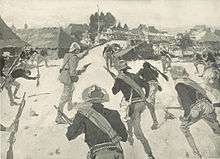Battle of Santa Cruz (1899)
For the WWII battle of the same name see: Battle of the Santa Cruz Islands
| Battle of Santa Cruz | |||||||
|---|---|---|---|---|---|---|---|
| Part of Philippine-American War | |||||||
Battle of Santa Cruz, Laguna (48th Squadron) | |||||||
| |||||||
| Belligerents | |||||||
|
|
| ||||||
| Commanders and leaders | |||||||
|
Henry W. Lawton Charles King | ? | ||||||
| Strength | |||||||
| provisional brigade | ? | ||||||
| Casualties and losses | |||||||
|
1 killed 9 wounded[1] |
93 killed[1] 40 wounded | ||||||

This Battle of Santa Cruz was a battle fought in the early stages of the Philippine-American War during General Henry W. Lawton's Laguna de Bay Campaign.
Background
After defeating the Filipino nationalists at the second battle of Manila, General Elwell S. Otis, commander of the US VIII Corps, sent the 1st Division under Arthur MacArthur to the north to threaten the Filipino capitol at Malolos.[2] At the same time, the 2nd Division under Henry W. Lawton was sent south into the Laguna province, to the Filipino stronghold located in the town of Santa Cruz.[3]
Landings
On April 8, 1899, Lawton's division boarded a small fleet of cascos escorted by the gunboats Oeste and Napindan, on the Pasig River east of Manila and sailed towards Laguna de Bay.[3] The flotilla did not reach the opposite shore of the lake until early afternoon the next day, because the pilots were unfamiliar with the river and frequently grounded the boats.[1] At 10:30 a.m. on April 9, landing craft began offloading Lawton's troops south of the stronghold of Santa Cruz. Ashore in the afternoon of April 9, the troops set out for Santa Cruz in a long skirmish line, advancing through driving rain.[1] At 5:45 p.m., the right flank, consisting of the 1st Idaho and 14th Infantry, encountered a defense complex of entrenchments and bamboo obstructions, through which they advanced slowly against resistance, until darkness fell, when the troops camped in the fields.[1]
Advance on Santa Cruz
Early on April 10, General Lawton personally went ashore with the 4th Cavalry north of town.[1] They advanced along the main road leading into the town. The road was lightly guarded until the approach to a bridge just outside the town, which was heavily guarded by the Filipinos. Lawton ordered a charge and a regular battalion supported by Idaho and Washington volunteers routed the local force. That same day, Lawton took control of Santa Cruz as the local units withdrew to Pagsanjan.[4]
While Gen. Lawton consolidated his forces in Santa Cruz, he planned to push on to Pagsanjan where he figured the Filipinos had retreated. After capturing Pagsanjan on April 11, he again defeated the Filipinos in a stiff engagement at the Battle of Paete.[4]
Withdrawal
On April 16, Lawton's forces reboarded their transport ships to return to Manila, noticing enemy soldiers entering the town as they left.[5]
Results and aftermath
Overall, the results of the Santa Cruz expedition amounted to the capture of six launches and the deaths of some 125 Filipino soldiers.[5]Linn 2000, p. 103 After the expedition, Aguinaldo ordered forces an Cavite, Batangas, and Laguna to concentrate at Muntinlupa, tying up manpower south of Manila which might otherwise have gone north.[5] The expedition demonstrated that towns on Laguna de Bay were vulnerable to raiders, forcing local officials to keep their military forces close to home in case of defensive need.[6]
References
- 1 2 3 4 5 6 Linn 2000, p. 102.
- ↑ Linn, Brian McAllister (2000). The Philippine War, 1899-1902. University Press of Kansas. pp. 95–101. ISBN 978-0-7006-1225-3.
- 1 2 Linn 2000, pp. 101–102.
- 1 2 Report of an Expedition to the Province of La Laguna, Luzon, Philippine Islands, April 8th to April 17th 1899, Major General H.W. Lawton.
- 1 2 3 Linn 2000, p. 103.
- ↑ Linn 2000, pp. 103–104.
External links
| Wikimedia Commons has media related to Battle of Santa Cruz (1899). |